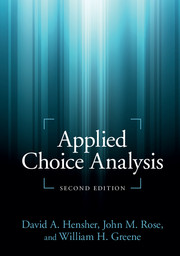Book contents
- Frontmatter
- Contents
- List of Figures
- List of Tables
- Preface
- Part I Getting started
- Part II Software and data
- Part III The suite of choice models
- 11 Getting started modeling: the workhorse – multinomial logit
- 12 Handling unlabeled discrete choice data
- 13 Getting more from your model
- 14 Nested logit estimation
- 15 Mixed logit estimation
- 16 Latent class models
- 17 Binary choice models
- 18 Ordered choices
- 19 Combining sources of data
- Part IV Advanced topics
- Select glossary
- References
- Index
11 - Getting started modeling: the workhorse – multinomial logit
from Part III - The suite of choice models
Published online by Cambridge University Press: 05 June 2015
- Frontmatter
- Contents
- List of Figures
- List of Tables
- Preface
- Part I Getting started
- Part II Software and data
- Part III The suite of choice models
- 11 Getting started modeling: the workhorse – multinomial logit
- 12 Handling unlabeled discrete choice data
- 13 Getting more from your model
- 14 Nested logit estimation
- 15 Mixed logit estimation
- 16 Latent class models
- 17 Binary choice models
- 18 Ordered choices
- 19 Combining sources of data
- Part IV Advanced topics
- Select glossary
- References
- Index
Summary
An economist is an expert who will know tomorrow why the things he predicted yesterday didn’t happen today.
(Laurance J. Peter 1919–90)Introduction
In this chapter we demonstrate, through the use of a labeled mode choice data set (summarized in Appendix 11A to this chapter), how to model choice data by means of Nlogit. In writing this chapter we have been very specific. We demonstrate line by line the commands necessary to estimate a model in Nlogit. We do likewise with the output, describing in detail what each line of output means in practical terms. Knowing that “one must learn to walk before one runs,” we begin with estimation of the most basic of choice models, the multinomial logit (MNL). We devote Chapter 12 to additional output that may be obtained for the basic MNL model and later chapters (especially Chapters 21–22) to more advanced models.
Modeling choice in Nlogit: the MNL command
The basic commands necessary for the estimation of choice models in Nlogit are as follows:
NLOGIT
;lhs = choice, cset, altij
;choices =<names of alternatives>
;Model:
U(alternative 1 name) = <utility function 1>/
U(alternative 2 name) = <utility function 2>/
…
U(alternative i name) = <utility function i>$
We will use this command syntax with the labeled mode choice data described in Chapter 10, shown here as:
Nlogit
;lhs = choice, cset, altij
;choices = bs,tn,bw,cr
;model:
u(bs) = bs + actpt*act + invcpt*invc + invtpt*invt2 + egtpt*egt + trpt*trnf /
u(tn) = tn + actpt*act + invcpt*invc + invtpt*invt2 + egtpt*egt + trpt*trnf /
u(bw) = bw + actpt*act + invcpt*invc + invtpt*invt2 + egtpt*egt + trpt*trnf /
u(cr) = invccr*invc + invtcar*invt + TC*TC + PC*PC + egtcar*egt $
While other command structures are possible (e.g., using RHS and RH2 instead of specifying the utility functions – we do not describe these here and refer the interested reader to Nlogit’s help references), the above format provides the analyst with the greatest flexibility in specifying choice models. It is for this reason that we use this command format over the other formats available.
- Type
- Chapter
- Information
- Applied Choice Analysis , pp. 437 - 471Publisher: Cambridge University PressPrint publication year: 2015



